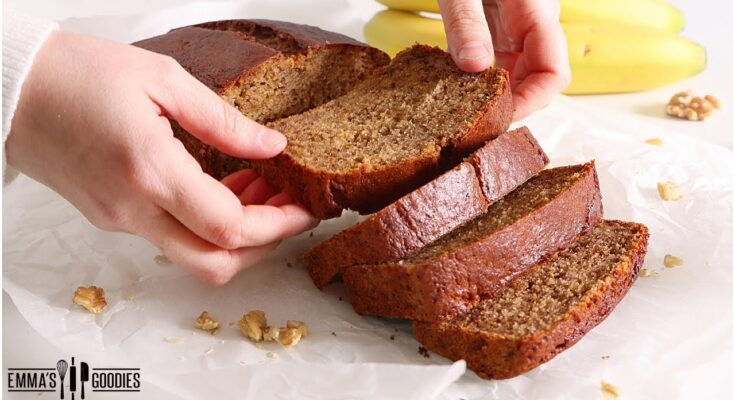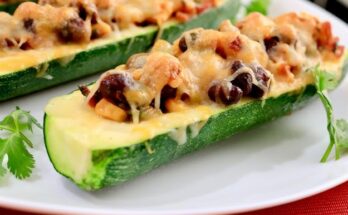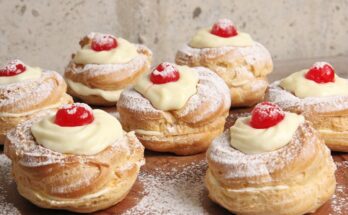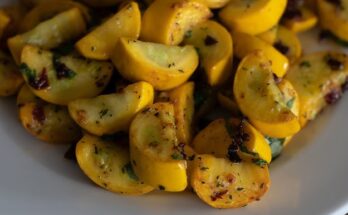Amazing Banana Bread Recipe: Let’s be real—banana bread isn’t just food, it’s comfort in loaf form. It’s the kind of treat that makes your kitchen smell heavenly and your heart feel a little warmer. What makes banana bread so beloved? For one, it’s a great way to use those overripe bananas you forgot on the counter. But more than that, it’s versatile, simple, and always delivers that soft, moist, cake-like goodness that keeps you coming back for more.
Whether you’re new to baking or you’ve been whipping up treats for years, banana bread is that foolproof recipe that rarely disappoints. You can have it plain, jazz it up with chocolate chips, or throw in some walnuts for a satisfying crunch. There’s room for creativity, but the classic recipe still reigns supreme—and that’s exactly what you’re getting here.
Origin and Popularity of Banana Bread
Banana bread found its way into homes during the Great Depression, when frugality met innovation. People didn’t want to waste food, especially fruit that was just a bit too ripe. So they mashed those soft bananas and turned them into a sweet, dense loaf. Ever since, it’s been a staple in American kitchens.
Today, you’ll find banana bread recipes all over the world. It’s a common sight in cafés, home kitchens, and even school lunchboxes. With hundreds of variations and plenty of ways to personalize the loaf, it’s no surprise that this humble recipe continues to hold a special place in our hearts—and our ovens.
Ingredients You’ll Need
Essential Ingredients
Let’s break down what you’ll need to make a classic loaf of banana bread. Here’s the go-to ingredient list:
- 3 ripe bananas – The riper, the better. Think speckled and soft.
- 1/2 cup (1 stick) unsalted butter – Melted. Adds richness and moisture.
- 3/4 cup sugar – You can use white, brown, or a mix of both.
- 2 eggs – Helps bind the ingredients and gives structure.
- 1 teaspoon vanilla extract – Adds a warm, sweet flavor.
- 1 1/2 cups all-purpose flour – The foundation of your loaf.
- 1 teaspoon baking soda – Helps the bread rise.
- 1/2 teaspoon salt – Balances the sweetness and enhances flavor.
These ingredients make a beautifully moist, flavorful loaf with just the right balance of sweet and savory.
Optional Add-Ins for a Twist
Want to get a little creative? Try mixing in one or more of these:
- 1/2 cup chopped walnuts or pecans – For crunch and nutty flavor.
- 1/2 cup chocolate chips – Who can resist melty chocolate?
- 1/4 cup shredded coconut – Adds a chewy, tropical twist.
- 1/2 teaspoon cinnamon or nutmeg – For a spiced, cozy vibe.
Optional ingredients let you experiment without straying too far from the original. You get to make the recipe your own without losing the magic of classic banana bread.
Equipment Required
Kitchen Tools That Make a Difference
You don’t need a fancy kitchen setup to make banana bread, but having the right tools will definitely make the process smoother. Here’s what you’ll want to have on hand:
- Mixing bowls – One for wet ingredients, one for dry.
- Measuring cups and spoons – Accuracy is key for great baking.
- Whisk or electric mixer – To blend everything until smooth.
- Rubber spatula – Helps you fold ingredients without overmixing.
- 8×4 or 9×5 inch loaf pan – The perfect size for a banana bread loaf.
- Oven mitts – Safety first!
- Cooling rack – Allows air circulation so your loaf cools evenly.
These tools don’t just make life easier—they ensure that your banana bread turns out just the way you want it: moist, fluffy, and perfectly baked.
Preparation Tips Before Baking
Choosing the Right Bananas
This might be the most important part of the entire recipe. The best bananas for banana bread are the ones you’d never eat on their own—think brown, soft, even a little gooey. That’s because the sugar content increases as bananas ripen, giving your bread a naturally sweet and deep banana flavor.
Pro tip: If you only have yellow bananas and you’re dying to bake, pop them in the oven at 300°F (150°C) for about 15–20 minutes. The skins will blacken and the insides will soften, mimicking the ripeness you want for banana bread.
Proper Mixing Techniques
When it comes to banana bread, overmixing is your enemy. You want to mix just enough to combine the ingredients. Overmixing the batter activates the gluten in the flour too much, which can make your bread dense or chewy.
Use a gentle hand when folding your wet and dry ingredients together. Don’t worry about lumps—those will work themselves out in the oven. The goal here is a slightly thick, pourable batter that holds its shape when you scrape it into the loaf pan.
Step-by-Step Banana Bread Recipe
Step 1: Preheat and Prep
Before you do anything else, preheat your oven to 350°F (175°C). While it’s heating, grease your loaf pan with a bit of butter or line it with parchment paper for easy removal. Having everything ready before you start mixing makes the whole process smoother.
Step 2: Mash and Mix Wet Ingredients
Peel your ripe bananas and mash them in a mixing bowl with a fork or potato masher until smooth with a few small lumps. Add the melted butter, sugar, eggs, and vanilla extract. Whisk until fully combined. This step is where your flavor base really comes together.
Step 3: Combine Dry Ingredients
In a separate bowl, whisk together your flour, baking soda, and salt. This might seem like a small step, but it’s crucial. Mixing the dry ingredients separately ensures that the baking soda and salt are evenly distributed throughout the flour before they meet the wet ingredients. If you skip this, you might end up with little pockets of bitterness or uneven rise.
If you’re planning to add mix-ins like chocolate chips, chopped nuts, or shredded coconut, now’s the time to toss them into the dry mix. Coating them with flour keeps them from sinking to the bottom of your loaf while it bakes.
Step 4: Mix Everything Together
Now comes the magic moment—bringing it all together. Slowly add your dry mixture into the wet ingredients, stirring gently as you go. Use a spatula or wooden spoon to fold the mixture rather than beating it. Remember, you’re not trying to whip it into a frenzy; you just want everything incorporated smoothly.
The result should be a thick, slightly lumpy batter. If it’s too runny, double-check your measurements. If it’s too dry, your bananas might not have been ripe enough. A splash of milk or a little yogurt can help loosen it up without compromising the flavor.
Step 5: Pour and Bake
Once your batter is ready, pour it into your prepared loaf pan. Use a spatula to smooth out the top, but don’t worry if it’s not perfect—the oven will take care of that. Place it on the middle rack of your preheated oven and bake for 55–65 minutes.
Start checking around the 50-minute mark. Ovens vary, and banana bread can go from perfectly golden to overly browned quickly. If the top is getting too dark before the middle is set, loosely cover the loaf with aluminum foil for the last 10–15 minutes of baking.
Baking Time and Temperature Guide
Getting the Perfect Texture
Temperature and time can make or break your banana bread. Baking at 350°F (175°C) is the sweet spot for most home ovens. It gives the loaf enough time to cook through evenly without drying out or burning the top.
Here’s a quick guide to help you adjust based on your pan size:
| Pan Size | Temperature | Bake Time |
|---|---|---|
| 8×4 inch | 350°F (175°C) | 60–65 minutes |
| 9×5 inch | 350°F (175°C) | 50–55 minutes |
| Mini loaf pans | 350°F (175°C) | 25–30 minutes |
| Muffin tin | 350°F (175°C) | 20–25 minutes |
Avoid opening the oven door repeatedly—each time you do, the temperature drops and can mess with the rise. Rely on the smell and the timer. When your kitchen smells like heaven, it’s probably close to done.
How to Tell If Your Banana Bread is Done
The Toothpick Trick
There’s a simple, no-fail method to check if your banana bread is perfectly baked: the toothpick test.
Grab a toothpick or a thin knife and insert it into the center of the loaf. If it comes out clean or with just a few moist crumbs, your banana bread is ready. If it’s got wet batter on it, give it another 5–10 minutes and check again.
Pay close attention to the edges too—they should pull slightly away from the pan, and the top should be golden brown and slightly cracked. That’s the sweet spot where flavor and texture meet.
Still unsure? Gently press the top of the loaf. It should spring back when touched, not feel squishy or overly soft.
Cooling and Serving Suggestions
Best Practices for Moist Bread
Resist the urge to cut into your banana bread the second it comes out of the oven. I know—it smells divine. But letting it cool is what seals in the moisture and keeps it from crumbling when you slice it.
Let the loaf sit in the pan for 10–15 minutes. Then transfer it to a wire rack to cool completely. This allows air to circulate and prevents the bottom from becoming soggy.
Once cool, slice and serve. Banana bread is amazing warm with a pat of butter, a drizzle of honey, or even a scoop of vanilla ice cream for dessert.
Want to level it up? Toast a slice for breakfast and top it with almond butter and banana slices. Or smear it with cream cheese for a tangy twist.
Storing and Reheating Banana Bread
Keeping It Fresh for Days
Banana bread is one of those treats that actually tastes better the next day—if you can wait that long! Proper storage is the key to maintaining its moist texture and rich flavor over several days.
To keep it fresh at room temperature:
- Wrap the loaf tightly in plastic wrap or aluminum foil.
- Alternatively, store it in an airtight container.
- Keep it on your countertop away from direct sunlight and heat.
Properly stored, banana bread can last up to 4 days at room temperature. If you want to stretch that to a week, place it in the fridge. Just make sure it’s sealed well so it doesn’t dry out.
Reheating Tips:
- For a quick slice, pop it in the microwave for 10–15 seconds.
- To revive the entire loaf, preheat your oven to 300°F (150°C), wrap the bread in foil, and warm it for 10–15 minutes.
- Add a dab of butter or a drizzle of honey right after reheating for an extra touch of deliciousness.
And yes—you can freeze it too! Wrap slices or the whole loaf in plastic wrap and then in a freezer-safe bag. When the craving hits, thaw it at room temperature or reheat from frozen.
Creative Banana Bread Variations
Chocolate Chip Banana Bread
Chocolate and banana? Yes, please! To make a chocolate chip version:
- Simply fold in 1/2 to 3/4 cup of chocolate chips into the batter before baking.
- Semi-sweet, milk, or dark chocolate chips all work wonderfully.
The chips melt into gooey pockets of sweetness that take your banana bread to dessert status.
Nutty Banana Bread
For those who love a little crunch, adding nuts is a no-brainer.
- Use 1/2 cup of chopped walnuts, pecans, or almonds.
- Toast them beforehand for extra flavor depth.
Nuts add texture and a nutty richness that pairs beautifully with banana.
Vegan Banana Bread
No eggs? No problem. You can still enjoy banana bread with a few simple swaps:
- Use flax eggs (1 tbsp ground flax + 2.5 tbsp water = 1 egg).
- Substitute butter with coconut oil or vegan butter.
- Choose plant-based milk or skip it if your batter has enough moisture.
The result? Still moist, still delicious, and 100% plant-based.
Common Mistakes to Avoid
What Can Go Wrong and How to Fix It
Even with a simple recipe like banana bread, a few small mistakes can lead to disappointing results. Here’s what to watch out for:
1. Using underripe bananas: This is the biggest flavor killer. If your bananas aren’t brown and mushy, your bread will be dry and bland.
2. Overmixing the batter: This activates too much gluten and makes the bread tough. Mix just until everything is combined.
3. Not measuring properly: Baking is a science. Use the spoon-and-level method for flour and always double-check your quantities.
4. Overbaking: Keep a close eye on that timer and test early. Overbaking dries out the loaf quickly.
5. Cutting too soon: Patience pays off. Let the bread cool before slicing to prevent it from falling apart.
6. Skipping the salt: Even in sweet baking, salt enhances flavor. Don’t skip it!
Fixing these simple mistakes can take your banana bread from just okay to absolutely amazing.
Banana Bread Nutrition Facts
What’s Inside a Slice
Banana bread may not be a diet food, but it’s certainly a feel-good food. Here’s a breakdown of what’s typically in one medium slice (based on a classic recipe with no add-ins):
| Nutrient | Amount per slice |
|---|---|
| Calories | 180–220 |
| Total Fat | 8–10g |
| Saturated Fat | 4g |
| Carbohydrates | 30–35g |
| Sugar | 14–18g |
| Protein | 3–4g |
| Fiber | 1–2g |
These values can vary depending on your ingredients and portion sizes. For a healthier loaf, try reducing the sugar, swapping white flour for whole wheat, or using applesauce instead of butter.
FAQs about Amazing Banana Bread Recipe
1. Can I use overripe bananas for banana bread?
Absolutely! Overripe bananas are the best for banana bread because they’re sweeter and mash easily, giving your bread rich flavor and moist texture.
2. How do I keep banana bread moist?
Store your banana bread in an airtight container at room temperature for up to 3 days. For longer storage, wrap it tightly in plastic wrap and freeze it.
3. Can I add nuts or chocolate chips?
Yes! Chopped walnuts, pecans, or chocolate chips are great add-ins. Fold them into the batter before baking for extra texture and flavor.
4. Why is my banana bread dense or gummy?
Overmixing the batter can cause this. Stir just until the ingredients are combined to avoid activating too much gluten, which leads to a dense texture.
5. Can I make banana bread without eggs?
Yes. You can substitute eggs with mashed bananas, applesauce, yogurt, or commercial egg replacers. Each option slightly changes the texture.
6. What type of flour is best for banana bread?
All-purpose flour works best. For healthier versions, try whole wheat flour or a gluten-free blend, but note it may affect the texture slightly.
7. How do I know when banana bread is done?
Insert a toothpick into the center—if it comes out clean or with a few crumbs, it’s done. The top should also be golden brown and firm to the touch.
Conclusion
There’s something incredibly comforting about homemade banana bread. It’s simple, versatile, and filled with nostalgia. From the moment you mash those bananas to the aroma filling your kitchen, this loaf is all about warmth and satisfaction.
With this easy step-by-step guide, you’ve got everything you need to bake the perfect loaf—whether you’re making it for a weekend brunch, gifting it to a friend, or just treating yourself.
So the next time you see those bananas turning brown, don’t toss them—turn them into something amazing.



